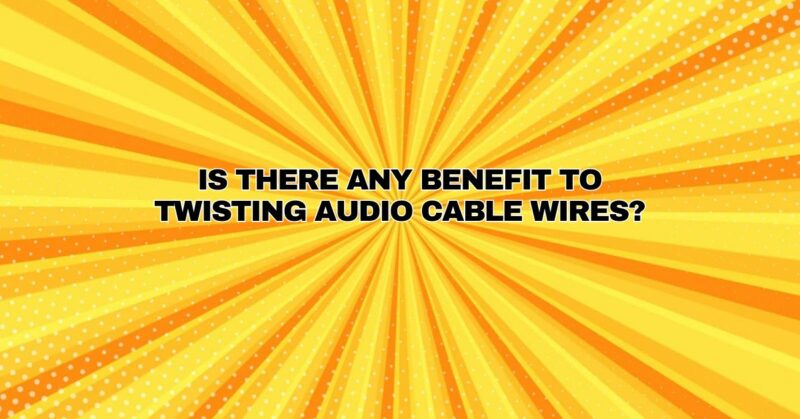Audio cables play a crucial role in transmitting sound signals from one audio component to another, whether it’s from your instrument to an amplifier, a turntable to a receiver, or any other audio source to a speaker. Over time, various techniques and practices have emerged in the audio world, including the act of twisting audio cable wires. But is there any real benefit to this practice, or is it just an old habit? In this comprehensive article, we’ll explore the concept of twisting audio cable wires, its history, potential benefits, and considerations to help you understand whether it’s a worthwhile practice in your audio setup.
The Tradition of Twisted Cable Wires
Twisting audio cable wires is a tradition rooted in the early days of audio engineering and telecommunication. It draws inspiration from practices like “twisted pair” wiring used in telegraphy and telephone systems dating back to the 19th century. The fundamental idea behind twisting is to reduce interference and enhance signal integrity. Let’s delve into the potential benefits and considerations associated with this practice.
Benefits of Twisting Audio Cable Wires
- EMI and RFI Reduction: Twisting audio cable wires can help mitigate electromagnetic interference (EMI) and radio-frequency interference (RFI). When audio cables run alongside power cables or other electronic devices, EMI and RFI can introduce unwanted noise into the audio signal. Twisting the cables can reduce the pickup of such interference.
- Common-Mode Noise Rejection: Twisted cables are effective at rejecting common-mode noise, which occurs when interference affects both conductors in the cable equally. The twisting pattern creates a balanced configuration that cancels out common-mode noise, enhancing signal purity.
- Improved Crosstalk Isolation: In multi-channel audio setups, such as stereo or surround sound systems, crosstalk—unwanted signal bleed between channels—can be an issue. Twisted pairs can reduce crosstalk by providing a barrier that limits signal leakage between conductors.
- Consistent Impedance: Twisting maintains a consistent impedance along the length of the cable. This uniformity is important, especially in high-frequency audio applications, as it prevents signal reflections and impedance mismatches that could degrade audio quality.
- Durability: The twisting of cable pairs can add a layer of mechanical stability and durability. It helps prevent cable tangling, kinking, and damage, extending the cable’s lifespan.
Considerations for Twisting Audio Cable Wires
While there are benefits to twisting audio cable wires, there are also some considerations to keep in mind:
- Twist Rate: The effectiveness of twisting depends on the twist rate—the number of twists per unit length. Different cable types may require specific twist rates to optimize performance. Over-twisting or under-twisting can have unintended consequences.
- Cable Type: Not all audio cables benefit equally from twisting. Twisted pair cables, commonly used in balanced audio connections, are designed with twisting in mind. Other cable types, such as coaxial cables, may not see the same advantages.
- Length and Application: The benefits of twisting become more pronounced with longer cable lengths and in situations where interference is more prevalent. In short cable runs or low-noise environments, the impact may be negligible.
- Connector Quality: The quality of connectors and terminations at both ends of the cable can significantly affect signal integrity. High-quality connectors and proper termination techniques are essential for optimal performance.
- Proper Cable Dressing: Twisting alone is not a cure-all for interference issues. Proper cable dressing, including separation from power cables and securing cables to prevent movement, is essential for minimizing interference.
Conclusion
Twisting audio cable wires is a practice rooted in the pursuit of signal purity and interference reduction. While it offers tangible benefits, such as EMI and RFI reduction, crosstalk isolation, and improved impedance consistency, its effectiveness depends on various factors, including cable type, length, and application.
When setting up your audio system, it’s essential to strike a balance between proper cable management, quality connectors, and appropriate cable types to optimize audio signal integrity. Twisting audio cable wires can be a valuable tool in your quest for pristine audio quality, especially in situations where interference is a concern. However, understanding the specific requirements of your audio setup and the characteristics of your cables is key to harnessing the benefits of this age-old practice.


